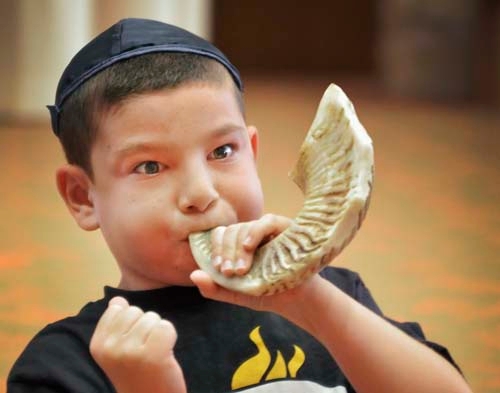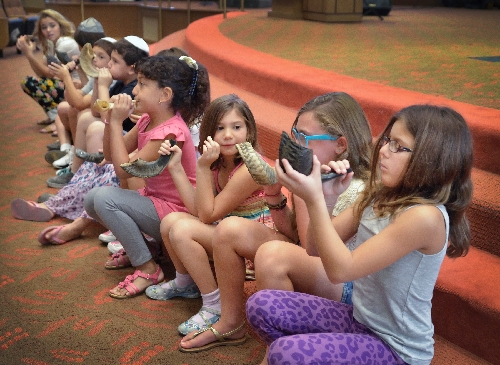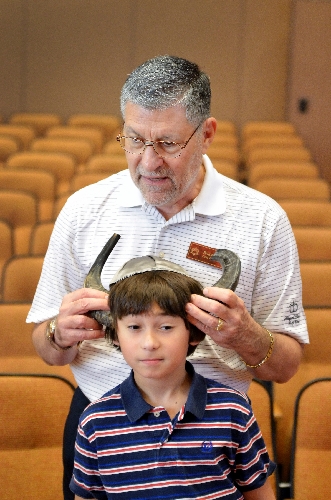Henderson shofar choir echoes traditional start of Rosh Hashana
There's no way around it: The sound filling the sanctuary of Congregation Ner Tamid resembles the pained bleating of a herd of water buffalo after a lunch of profoundly questionable burritos.
Yet, a funny thing happens: Not a half-hour later, when the congregation's religious school students have begun to figure out the bizarre musical instruments they'd been handed, the bleats begin to take on an almost majestic quality.
That, in turn, bodes well for Monday, when Congregation Ner Tamid's Youth Shofar Choir will participate in the synagogue's Rosh Hashana service by playing an instrument linked to hundreds of years of Jewish history.
Rosh Hashana, which begins at sundown today, marks the start of the Jewish New Year and the High Holidays, a 10-day period of repentance that concludes on Yom Kippur, the Day of Atonement and the holiest day of the Jewish calendar.
The sound of the shofar calls the Jewish people to worship on Rosh Hashana and heralds the arrival of the new year. And this year, for the fourth year in a row, Congregation Ner Tamid's Youth Shofar Choir, made up of third- through seventh-graders, will sound the shofar during Rosh Hashana services.
Bruce Matza, Congregation Ner Tamid's past president, has been teaching youth shofar choirs for about 30 years. He says teaching children how to sound the shofar offers them the chance to "do something very special, very traditional and very unique, and (that is) perceived by adults as something that is very difficult to learn how to do."
Playing the shofar during Rosh Hashana services "helps them connect to their heritage and gives them a sense of importance," Matza adds. "I've had them tell me years later that that was the most influential thing that kept them Jewish."
Congregation Ner Tamid's Youth Shofar Choir this year will include about 120 students from the synagogue's religious school. Last week, during their first rehearsal, the students reacquainted - or, in the case of third-graders, acquainted - themselves with the instrument.
The shofar is made from a ram's horn that is dried, hollowed out and cleaned. Openings allow the player to blow into one end and for the instrument's deep, throbbing tones to come out of the other.
In the middle - well, they smell a bit funky.
"It smells like an animal," Matza explains. "They've got a wet dog smell about them."
While proficient shofar players actually can wrest melodies from a shofar, it's not an instrument designed for singalongs. Rather, Matza says, the shofar was used long ago as a signaling device to, for example, call people to worship, to announce the presence of a potentially dangerous stranger or a wild animal, or signal a joyous occasion.
Today, the shofar's sound serves a symbolic function in Jewish religious observances, most notably at Rosh Hashana. After Matza explains to third-graders what Rosh Hashana and the shofar are all about, he asks the kids to choose their very first shofars.
Then, Matza demonstrates how the shofar is played: By placing the lips against the smaller opening and blowing out forcefully, vibrating the lips to create a buzzing sound.
"It's like blowing a trumpet without the mouthpiece," Matza explains. "You've got to blow into the natural shape of the horn. You cannot use anything artificial to create the buzz."
You know how moms and dads hate it when kids spit and make disgusting noises with their mouths? To them, Matza offers: "When you play the shofar, you get to spit and make funny noises with your mouth."
The notion seems appealing to a few of the shofar novices, although several continue to regard their horns with wariness.
"Am I going to have bad breath after?" one girl asks, scrunching her face as she sniffs her horn's insides.
The third-graders' first few collective blows yield mostly loud puffs of air and erratic, warbling tones, although a few already are well on their way toward creating sustained notes. So, the kids break into smaller groups to practice with teen instructors Niah Anson and Julia Smith.
Smith, an eighth-grader at Bob Miller Middle School, joined the Youth Shofar Choir four years ago and admits that, the first time she picked up a shofar, "I thought Bruce was crazy. I thought, 'How am I going to do this? I don't play any instrument.' "
And the first time she elicited a solid sound from it?
"It was awesome," she answers. "It was cool."
So is the shofar's heritage. Once, while practicing outside at her home - "Of course I couldn't do it in the house," Smith says with a laugh - a friend stopped by and saw her.
"She looked at me and said, 'Oh my god, you are so Jewish,' " Smith recalls, laughing.
"I'm, like, what are you talking about? She said: 'I've never heard of somebody doing this. I've never seen somebody do this. I've heard of people playing conch shells and ridiculous stuff like that, but blowing a shofar, that is so awesome.' "
Anson finds sounding the shofar to be "a very surreal experience."
Anson, a junior at Adelson Educational Campus, grew up hearing her father sound the shofar at Rosh Hashana, and, "I always thought it was the coolest thing in the world."
She's pretty proficient at the shofar now - Matza admits that, the previous day, Anson beat him in an informal who-can-hold-a-note-the-longest competition - and says that, while studying in Israel during her sophomore year, she even discovered "my own shofar" at a marketplace.
"I was just standing in the middle of the street, blowing these shofars," she says, smiling. "Everybody was staring, but you get that sound and you're just, like, 'OK, I've got it.' "
When the rest of Congregation Ner Tamid's religious school students join the third-graders, Matza demonstrates to the assembled choir the series of notes the children will play on Rosh Hashana: Tekiah, one long, clear-toned blast; Shevarim, three shorter blasts; Teruah, a series of rapid, short notes; and Tekiah Gedolah, a single, unbroken blast held for as long as possible.
Each series of notes holds specific symbolism, although that doesn't make the mechanics of creating them easy.
"My teeth are numb," one girl complains.
The tricky part for Matza is getting the choir to begin and end each tone together. But, by the time rehearsal ends, the choir is sounding good, and Matza is confident they'll have it together in time for Monday's service.
A bonus: The kids will get to keep their shofars for use next year and, then, as a lifelong remembrance of their Rosh Hashana service and having become select participants in a venerable, and powerful, Jewish tradition.
"There's not a handful of people who ever held a shofar, much less played one," Matza explains. "It's one of those sounds that's entrenched in the traditions and history of our people. When it's played, it's only played on the most important of holidays, and the entire congregation just sort of sits in awe."
Contact reporter John Przybys at jprzybys @reviewjournal.com or 702-383-0280.

























